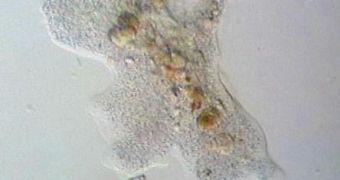Ophthalmologists recommend patients to use cleaning solutions for their contact lenses whenever they are not wearing them. But regardless of how often the lenses are cleaned, the risk of them being infected with pathogenic protozoa, like amoebas, remains the same. These unicellular organisms are extremely resilient and can cause severe eye infections that could lead to blindness.
By analyzing the incidence of amoebic keratitis, which is an eye disease caused by acanthamoeba, a species of protozoa, scientists found that more than 85 percent of all cases were registered in people who usually wore contact lenses. They identified tap water and swimming pools as the main source of amoeba infections. Tough water used daily is cleansed thoroughly before reaching homes, the sizes of the microorganisms allow them to escape even the most severe tests.
Chlorinated pools also revealed the existence of this amoeba, which means that people who swim wearing their contact lenses are at increased risk of contracting the pathogen agent. Regular water is also contaminated, so people who wash or rinse their lenses in it are also more prone to getting eye infections. Unfortunately, there are no ways of eliminating the protozoa from these waters at this point.
What's even more concerning is that contact lens cleaning solutions also fail to kill acanthamoeba, which enables it to live in the tight space between the lens and the eye, thus causing the infections. Studies have shown that short-term used lenses are less contaminated than those used for two months or a year. In long-term used ones, researchers identified highly-pathogenic amoeba that poses a severe risk for the health of the eyes.
"At the moment, we are developing a contact lens maintenance solution that can kill pathogenic Acanthamoeba species. We found that the antibiotic ciprofloxacin and the antiseptic chlorhexidine both kill Acanthamoeba," concluded Dr. Basilio Valladares, working from the University of La Laguna Institute of Tropical Diseases and Public Health of the Canary Islands.

 14 DAY TRIAL //
14 DAY TRIAL //